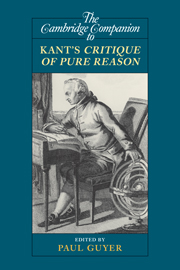Book contents
- Frontmatter
- Introduction
- Part I The Background to the Critique
- Part II The Arguments of the Critique
- Part III The Impact of the Critique
- 14 The Reception of the Critique of Pure Reason in German Idealism
- 15 The “Transcendental Method”: On the Reception of the Critique of Pure Reason in Neo-Kantianism
- 16 The Critique of Pure Reason and Continental Philosophy: Heidegger’s Interpretation of Transcendental Imagination
- 17 Kant’s Critique of Pure Reason and Analytic Philosophy
- Bibliography
- Index
15 - The “Transcendental Method”: On the Reception of the Critique of Pure Reason in Neo-Kantianism
from Part III - The Impact of the Critique
Published online by Cambridge University Press: 28 July 2010
- Frontmatter
- Introduction
- Part I The Background to the Critique
- Part II The Arguments of the Critique
- Part III The Impact of the Critique
- 14 The Reception of the Critique of Pure Reason in German Idealism
- 15 The “Transcendental Method”: On the Reception of the Critique of Pure Reason in Neo-Kantianism
- 16 The Critique of Pure Reason and Continental Philosophy: Heidegger’s Interpretation of Transcendental Imagination
- 17 Kant’s Critique of Pure Reason and Analytic Philosophy
- Bibliography
- Index
Summary
“The term 'neo-Kantianism' must be determined functionally rather than substantially [ . . . ]; it is a matter of a direction taken in question-posing.” / In the history of philosophy, there have been several waves of Kantianism since the first publication of the Critique of Pure Reason. They differ from each other not only with respect to the textual basis available at a certain point in time. They are also rooted in quite diverse motives of appropriation of Kant's philosophy and pursue different argumentative goals. The first wave appeared almost immediately after Kant had launched his critical project: Johann Schultz wrote the first commentary on the Critique of Pure Reason in 1784; Carl Christian Erhard Schmid published the first Kant dictionary in 1786; and in 1796, Jacob Sigismund Beck provided the rising German idealism with the Only possible standpoint from which the Critical Philosophy must be judged. Some of these early Kantians had an extensive correspondence with Kant, thereby supporting the development of Kant's philosophy in the first place. In contrast to the aims of Johann Gottlieb Fichte and other German idealists who no longer were Kant scholars, the aim of those Kantians was confined to a better understanding of Kant's critical works, starting with the Dissertation.
- Type
- Chapter
- Information
- The Cambridge Companion to Kant's Critique of Pure Reason , pp. 346 - 379Publisher: Cambridge University PressPrint publication year: 2010
- 7
- Cited by



